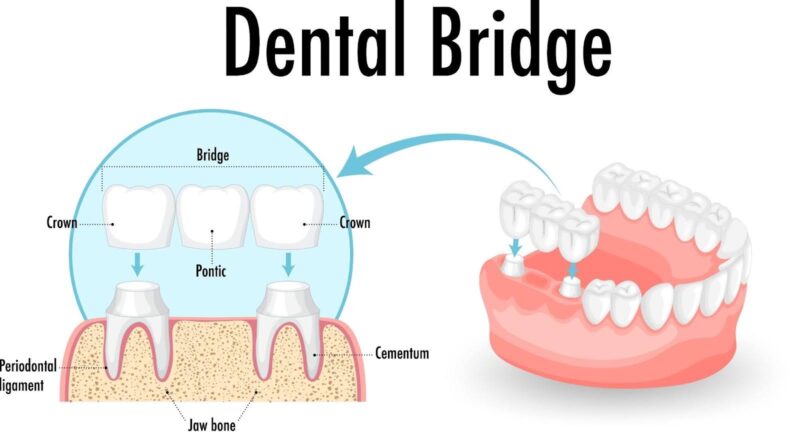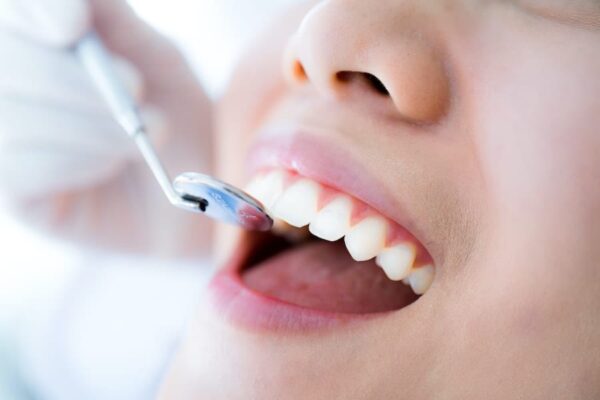Dental bridges are a popular solution for replacing missing teeth, restoring both functionality and aesthetics. In this article, we will explore the different types of dental bridges, their structure and materials, and how you can maintain them to ensure they last as long as possible.
What Is A Dental Bridge?
A dental bridge is a fixed dental restoration used to replace one or more missing teeth by joining an artificial tooth permanently to adjacent teeth or dental implants. Dental bridges not only improve the appearance of your smile but also restore your ability to chew and speak properly, maintain the shape of your face, and prevent remaining teeth from drifting out of position.
How Do Dental Bridges Work?
Dental bridges bridge the gap created by one or more missing teeth. The process involves preparing the teeth adjacent to the gap, which will serve as anchors (abutments). These abutments are reshaped to accommodate crowns that will hold the bridge in place. The artificial tooth (pontic) is then attached to these crowns. Dentists recommend dental bridges for their ability to provide a durable and aesthetically pleasing solution for missing teeth.
Types of Dental Bridges
Conventional Dental Bridges
Conventional dental bridges are the most common type and involve creating a crown for the teeth or implants on either side of the missing tooth, with a pontic in between. They are typically made of porcelain fused to metal or ceramics.
Cantilever Dental Bridges
Cantilever bridges are used when there are adjacent teeth on only one side of the missing tooth or teeth. This type of bridge is less common and generally used in areas of the mouth that are under less stress, such as the front teeth.
Implant-Supported Bridges
Implant-supported bridges use dental implants rather than crowns or frameworks. One implant is placed for every missing tooth, and these implants hold the bridge in position. This type of bridge is known for its strength and stability and is often recommended for patients missing multiple teeth.
How Long Do Dental Bridges Last?
The lifespan of a dental bridge can vary, but on average, they last between 5 to 15 years. With proper care and maintenance, some bridges can last even longer, providing a durable solution for missing teeth.
Factors That Affect How Long Dental Bridges Last
This should act as an introduction to the following subsections. Begin the discussion of how there are multiple factors that can influence the lifespan of a dental bridge.
Impact of Material on Dental Bridge Lifespan
Dental bridges can be made from various materials, including metal, ceramic, composite, and porcelain. Each material has its own set of advantages in terms of durability and aesthetics. Metal bridges, for example, are very durable but less aesthetically pleasing, while porcelain bridges blend well with natural teeth but may not be as strong as metal.
Procedure Duration and Its Effect on Dental Bridge Lifespan
The process of getting a dental bridge typically takes a few weeks, involving multiple visits to the dentist. The initial visit involves preparing the abutment teeth and taking impressions, which are then used to create the bridge. Once the bridge is ready, it is fitted and adjusted during the final visit. The precision and care taken during these steps can significantly impact the lifespan of the bridge.
Longevity of a Dental Bridge: What to Expect?
With proper oral hygiene and regular dental visits, a dental bridge is designed to last up to 15 years. Factors such as the patient’s bite, the location of the bridge, and the materials used all play a role in its longevity.
Maintaining and Extending the Lifespan of Dental Bridges
Maintaining your dental bridge requires good oral hygiene and regular dental check-ups. Here are some ways to ensure your bridge lasts as long as possible.
The Importance of Good Oral Hygiene for Dental Bridge Longevity
Daily habits such as brushing twice a day, flossing, and using mouthwash can help prevent plaque buildup around the bridge, which can lead to decay and gum disease. Special flossing tools and interdental brushes can be helpful in cleaning around the bridge and keeping it free from food particles and bacteria.
The Necessity of Regular Dental Check-ups
Routine dental visits are crucial for maintaining your dental bridge. During these check-ups, your dentist can detect any potential issues early on and provide the necessary treatments to prevent further complications. Regular professional cleanings also help keep your bridge and the surrounding teeth in optimal condition.
Dental Bridge Care: Tips and Tricks
To extend the lifespan of your dental bridge, avoid chewing on hard foods or objects, such as ice or pens, which can damage the bridge. Additionally, maintaining a balanced diet and avoiding sugary foods can help prevent decay and gum disease. If you grind your teeth at night, consider wearing a nightguard to protect your bridge and natural teeth.
Dental Bridge FAQs
Who is eligible for a dental bridge?
Most patients with one or more missing teeth are eligible for a dental bridge. However, healthy adjacent teeth or dental implants are necessary to support the bridge.
How quickly can a dental bridge replace missing teeth?
The process of getting a dental bridge usually takes two to three weeks, from the initial consultation to the final fitting.
What is the average lifespan of a dental bridge?
On average, dental bridges last between 5 to 15 years, depending on various factors such as the materials used and the patient’s oral hygiene practices.
Understanding the types of dental bridges, their materials, and how to care for them can significantly impact their longevity. At All Smiles Care, we are committed to providing quality dental bridges and comprehensive patient care. If you have any questions or are considering a dental bridge, please don’t hesitate to contact us for more information.



